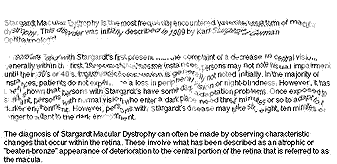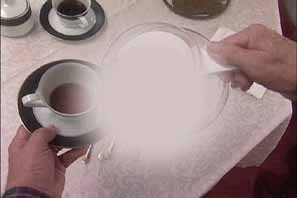Visual Symptoms of MD
What Do MD People See?
Most people with macular degeneration experience one or more of the following visual symptoms in either one or both eyes:
- Colors look dim
- Words on a page look blurred, as in this example:

- Straight lines look distorted, especially toward the center of vision, as in the following section of the Amsler Grid. (To go to an undistorted Amsler Grid to check your vision, click on the image below.)
- A dark or empty area appears in the center of vision, as in the picture below. To view this correctly, stare at the center of the blind area, and try to interpret the images in the periphery. A person with MD does not have the ability to look around that area, but must view everything “eccentrically.” To check your visual field for blind spots, go to the Visual Field Grid.

Other visual symptoms reported by MD people include:
- Photopsias, including flashes of light, spinning pinwheels of light, and/or fluid-like waves of light. These are thought to result from vitreous traction or misfiring of nerve cells, and are not considered harmful. A sudden shower of sparks, however, may indicate retinal detachment, and a doctor should be seen immediately.
- Floaters (see Glossary). Not harmful.
- Drusen (see Glossary)
- Double-vision (caused by one eye seeing differently than the other). Can sometimes be corrected with prismatic lenses.
- Poor scotopic (night) vision.
- “Imaging,” or transferance of a visual symptom from one eye to the other (possibly the result of one eye trying to compensate).
- Visual hallucinations. Some people report seeing images that are not actually there. This is the brain’s way of trying to make up for lost input, and should be considered more entertaining than harmful. For more information, see Charles Bonnet Syndrome.
This page last updated 6/16/07

